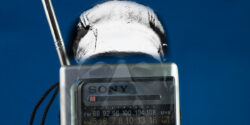The FCC is not in the business of taking licensed radio stations off the air.
This is something I’ve been telling community and college radio folks for well over a decade, especially when they get themselves tied up in knots of anxiety trying to read certain regulations like literary theory, worried that a fine over a fleeting f-word or clueless DJ promoting their own live gig once will spell the end. (It won’t, and hasn’t in the last four decades.)
There’s no better evidence for this perspective than the Commission’s latest proposed rulemaking to let FrankenFMs stay resident at the FM dial’s back door of 87.75 MHz, permanently.
To briefly review: FrankenFMs are TV stations broadcasting as radio stations that were never licensed as radio at all. Instead they’re the vestiges of analog low-power TV (LPTV) stations that broadcast on channel 6, where the formerly analog audio portion of their signals could be heard at the far left end of the FM dial. Essentially, once full-power TV in the US went all-digital in 2009, FrankenFMs exploited what was previously just a technical curiosity to create a backdoor service.
However, LPTVs had to go all-digital in June 2021, ending analog audio and FM radio reception at the same. But then the FCC authorized Special Temporary Authority (STA) for 13 of these stations to maintain an analog radio signal alongside their digital one, and those stations remain on the FM dial today.
With this new proposal, the Commission is recognizing that to listeners FrankenFMs are real radio stations, even if that’s not what the rules intended them to be. Of course, one could say the same of pirate stations – which the agency is staffing up to fight – but the Frankens at least were authorized to have an audio signal at 87.75 FM, just not necessarily a standalone signal. Yet, that was never prohibited either.
Say it again: The FCC is not in the business of taking licensed radio stations off the air.
(Even if they’re not fully radio stations.)
Of course, this proposal does not come without controversy. The most common objection is that it’s otherwise difficult to put a new FM station on the air, and so it would be fairer not to authorize this backdoor scheme. An additional argument is that if these stations are legitimized, then the Commission should extend the opportunity to more broadcasters.
In fact, the FCC asks if they should do just that, adopting an idea that’s been floating around community radio and public interest circles for the last decade, more recently suggested by National Public Radio: reallocate analog channel 6 TV frequencies 82 – 88 MHz for new FMs. Obviously, this would require new radio receivers to get most of the new broadcasts. But there was a time not too long ago that the AM dial didn’t go all the way to 1710 KHz, so there’s precedent.
No doubt, many entrenched broadcast interests will probably argue that it’s absurd to license frequencies for stations that won’t be heard on most receivers. I don’t think that is so absurd in today’s radio and media environment. I’ll make that case in a separate post.
Now we’re waiting for the comment window on this proposal to open when it gets published in the Federal Register. That’s when we’ll see what arguments, pro and con, are made on these ideas, and any of us in the public may weigh in, too.



